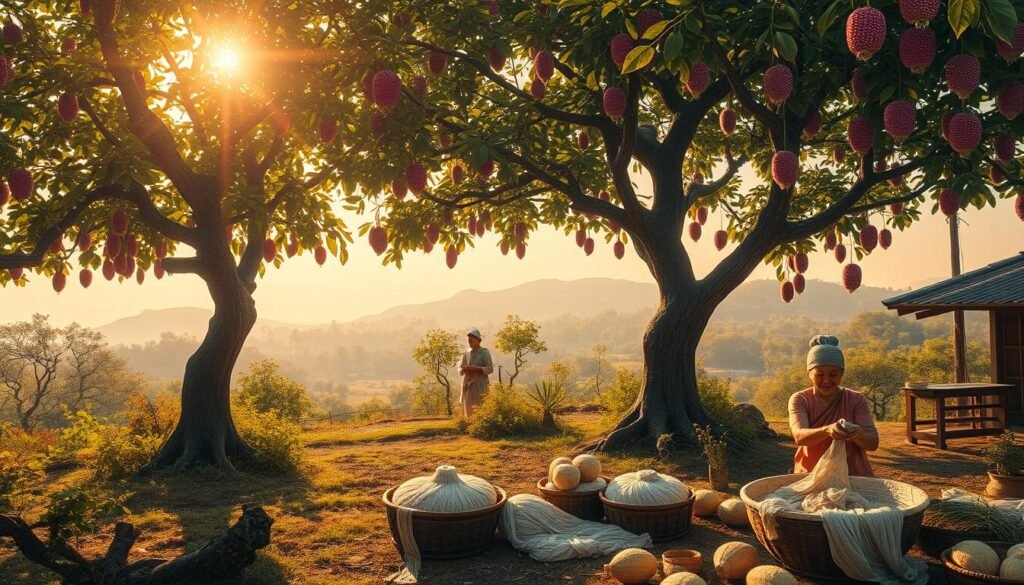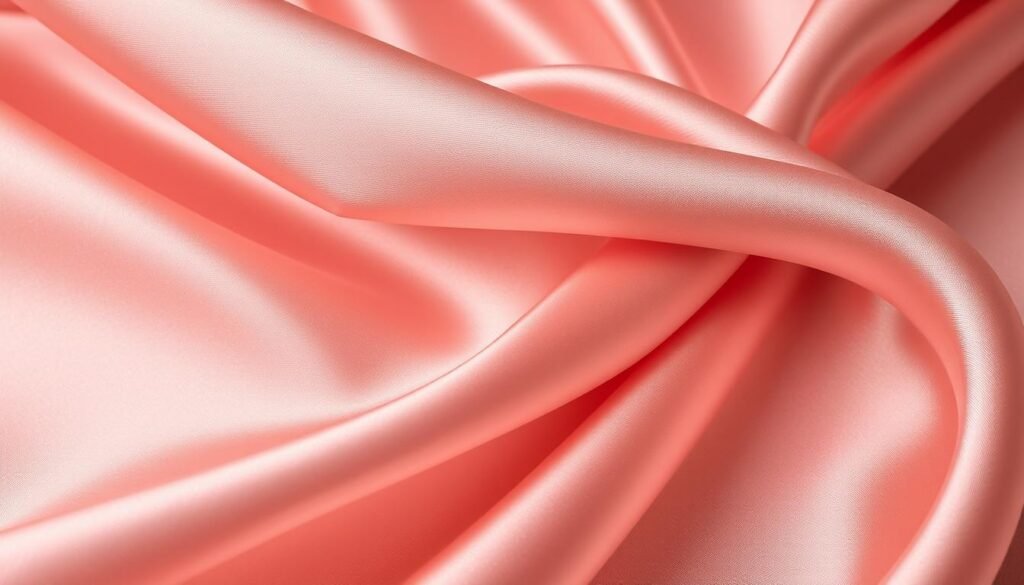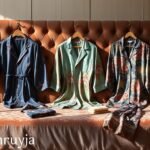Did you know silk has been around for over 4,000 years? It started in China around 3630 BC. This fabric is known for its elegance and strength. It was a secret in ancient China but is now loved for its smooth feel and ability to keep you cool.
Silk is called the “king of fabrics” for good reason. It’s a natural fiber that adds luxury to anything. Making silk is better for the planet than cotton, which is great for those who care about the environment. Silk has become a favorite in fashion and home decor around the world.
Tianruiyi is a top silk fabric maker. They offer the best silk fabrics and textiles. They focus on quality and craftsmanship. Their silk fabric is perfect for special dresses or adding elegance to your home.
Key Takeaways:
- Silk has a history dating back over four thousand years, originating in ancient China.
- Silk is highly valued for its smooth feel, breathability, and temperature-regulating properties.
- Silk production emits significantly less carbon compared to cotton production.
- Tianruiyi offers high-quality silk fabrics and textiles for fashion and home décor.
- Mulberry silk is considered the finest quality silk available.
Introduction to Silk Fabric
Silk fabric is known for its luxurious feel and elegant look. It has been loved for centuries. Made from silkworm cocoons, silk has a rich history and special qualities that make it stand out.

The History and Origins of Silk
The story of silk starts in ancient China. It’s said Empress Leizu, the Yellow Emperor’s wife, discovered silk around 2700 BC. The Chinese kept the secret of making silk for a long time, leading the world in silk trade.
The Silk Road, opened in the 1st millennium BC, helped spread silk worldwide. It became a sign of luxury and exclusivity in many cultures.
“The Silk Road was a network of trade routes connecting the East and West, and was central to the economic, cultural, political, and religious interactions between these regions from the 2nd century BCE to the 18th century.” – UNESCO
Today, China leads in silk production, making 146,000 metric tonnes a year. India, Uzbekistan, and Thailand also play big roles in the global silk market.
The Unique Properties of Silk
Silk is famous for its silk fabric properties. It’s strong, breathable, soft, and has a natural shine. Silk is also good for people with allergies.
Silk’s special qualities come from its main fiber, fibroin. This fiber is made by certain insects. The most famous silk comes from mulberry silkworms, raised for silk production.
| Silk Type | Origin | Characteristics |
|---|---|---|
| Mulberry Silk | China | Most widely produced, known for its softness and luster |
| Eri Silk | India | Also known as “peace silk,” as it does not require killing silkworms during production |
| Tasar Silk | India | Second-most produced type of silk fabric globally |
| Muga Silk | Assam, India | Exclusively produced in Assam, known for its unique qualities |
There are also rare silks like sea silk and spider silk. Sea silk is made from mussels, and spider silk is very strong but expensive. It’s mostly used for industrial purposes.
The Luxurious Feel of Silk
Silk comes from silkworms and is known for its softness and smoothness. It feels luxurious against the skin, making it popular for centuries. The silk fibers are fine and uniform, giving it a unique softness.

Silk also has a natural sheen and luster. This is because of its special fiber structure. It refracts light, creating a shimmering effect. This makes silk perfect for high-end fashion and home decor.
Smoothness and Softness
Silk is smoother and softer than most fabrics. Mulberry silk is the most prized for its smoothness. It’s made from silkworms that eat mulberry leaves, making it fine and lustrous.
Tussah silk comes from wild silkworms. It’s not as smooth but has a unique texture and golden color. It’s great for textured garments or home furnishings.
Natural Sheen and Luster
Silk’s natural sheen and luster are striking. The fibers reflect light, giving it a glow. This is most evident in fabrics like charmeuse and satin.
Silk’s natural luster and sheen make it perfect for evening wear and bridal gowns. It adds elegance and sophistication.
Dyeing techniques can enhance silk’s luster. Acid and reactive dyes create vibrant colors. This shows off silk’s natural beauty.
In the silk trade, its sheen and luster are highly valued. Silk’s shimmer, smoothness, and softness make it timeless and sought-after worldwide.
Properties of Silk Fabric
Silk is a natural protein fiber from silkworm cocoons. It has unique properties that make it popular in the textile world. Silk is strong, durable, breathable, and absorbs moisture well. It’s a versatile and luxurious fabric for fashion, home decor, and more.
Strength and Durability
Despite looking delicate, silk is incredibly strong. Its strength is similar to steel of the same thickness. This makes silk fabrics durable and less likely to tear or break.
Silk’s strength also means it lasts a long time. Silk clothes and accessories can be kept for generations. This makes silk a good choice for the environment and your wallet in the long run. In the silk garment industry, high-quality silk garments are valued for their lasting beauty.
Breathability and Thermal Regulation
Silk is very breathable, allowing air to circulate well. This makes it comfortable in different climates. Silk fibers absorb and release moisture quickly, helping to keep the body temperature right.
Silk is thermoregulatory, helping to maintain body temperature by providing proper air circulation.
This thermal regulation makes silk great for all seasons. It keeps you cool in summer and warm in winter. Silk’s breathability also makes it hypoallergenic, good for people with sensitive skin.
Absorbency and Drying Speed
Silk absorbs moisture quickly and dries fast. This is great for the Silk manufacturing, as it helps silk take dyes and prints well. This means silk can show off vibrant colors and patterns with less water and chemicals.
| Fabric | Moisture Absorbency | Drying Speed |
|---|---|---|
| Silk | 30% of its weight | Quick |
| Cotton | 25% of its weight | Moderate |
| Polyester | 0.4% of its weight | Fast |
Silk’s absorbency is also practical for daily wear. It absorbs sweat while letting the skin breathe. This keeps you feeling fresh and comfortable all day. Plus, silk dries quickly, making it easy to care for.
Types of Silk Fabric
Silk is a luxurious and versatile fabric with many types and varieties. Each has its own unique characteristics and uses. From mulberry silk to dupioni and shantung, there’s a wide range of fabrics for different needs.
Looking for something lightweight and flowing? Chiffon is perfect. Or maybe you need something more structured? Organza is a great choice. Silk fabrics offer many options for designers and consumers.
Charmeuse silk is known for its smooth, lustrous surface and fluid drape. It’s often used for elegant evening gowns and luxurious nightwear. Dupioni silk, with its crisp texture and subtle sheen, is great for bridal gowns and tailored suits.
Chiffon silk is ideal for a lighter, more ethereal look. It’s used in bridal gowns, feminine blouses, and delicate scarves. Habotai silk is versatile and used in blouses, skirts, linings, draperies, and craft projects.
“Silk fabrics offer an unparalleled combination of luxury, comfort, and style, making them a favorite among fashion enthusiasts and interior designers alike.” – Tianruiyi, a leading silk fabric manufacturer
There are also unique blends and combinations of silk. Silk-cotton blends have a smooth, glossy finish and anti-static properties. Silk-wool blends combine silk’s softness with wool’s warmth and durability. These blends open up new possibilities for innovative textiles.
| Silk Fabric Type | Characteristics | Common Uses |
|---|---|---|
| Mulberry Silk | Smooth, lustrous, and strong | Elegant attire, upscale decorative items |
| Charmeuse | Smooth, lustrous, and fluid drape | Evening gowns, nightwear, lingerie |
| Dupioni Silk | Crisp texture, subtle sheen | Bridal gowns, tailored suits, throw pillows |
| Chiffon Silk | Sheer, lightweight, and flowing | Bridal gowns, blouses, scarves |
| Habotai Silk | Versatile, smooth, and lightweight | Blouses, skirts, linings, draperies |
With so many silk varieties and accessories available, designers and consumers can explore each type’s unique properties and uses. From mulberry silk’s timeless elegance to silk blends’ innovative combinations, silk continues to inspire and captivate.
Mulberry Silk: The Queen of Silks
Mulberry silk is the most luxurious and sought-after silk type. It’s made by the Bombyx mori silkworm, which eats only mulberry leaves. This fabric is known for its softness, shine, and long-lasting quality. It’s called the “queen of silks” and makes up most of the world’s silk.
Characteristics of Mulberry Silk
Mulberry silk has many special qualities:
- It’s incredibly smooth and soft, feeling great on the skin.
- It has a natural shine that looks amazing.
- It’s light and lets air through, keeping you comfortable.
- It’s good for people with sensitive skin because it’s hypoallergenic.
- It keeps moisture away, helping to keep skin and hair healthy.
- It also fights mold and dust mites, making it great for bedding.
Applications of Mulberry Silk
Mulberry silk is used in many ways:
- In fashion, it’s used for high-end clothes, dresses, blouses, scarves, and ties.
- For home, it’s in pillowcases, sheets, duvets, and curtains.
- It’s also in accessories like eye masks, scrunchies, and hair ties.
- It’s used for fancy embroidery and decorations.
The quality of mulberry silk shows in its price. It’s more expensive than Eri silk but less than Muga silk. The momme weight, which shows its density, is usually between 19 and 30 momme. Higher numbers mean better quality and longer life.
| Silk Type | Texture | Weight | Best Uses |
|---|---|---|---|
| Mulberry Silk | Smooth and soft | Lightweight | Pillowcases, duvets, dresses, accessories |
| Eri Silk | Wooly feel | Heavier weight | Crocheting, knitting, embroidery |
| Muga Silk | Glossy texture | Lightweight | Wedding gowns, special occasion garments |
| Tasar Silk | Rougher texture | Lightweight | Embroidery, garments for warmer climates |
Mulberry silk is the top luxury silk. It’s soft, shiny, and lasts long. It’s perfect for fashion, bedding, and home decor because it’s soft and safe for skin.
Charmeuse and Satin Silk
Charmeuse silk and satin silk are top picks for their luxury and versatility. They drape elegantly and have a smooth, shiny finish. This makes them perfect for clothes and home decor.
The Lustrous Appeal of Charmeuse
Charmeuse silk has a unique look, with a shiny side and a dull side. It’s great for making fancy dresses, blouses, and lingerie. The shiny side comes from a satin weave, while the back is soft and matte.
Charmeuse silk comes in many colors, from brights to softs. You can find it in widths from 43 to 53 inches. Prices vary, starting at $34.00 and going up to $195.00, based on design and demand.
The Versatility of Satin Silk
Satin silk has a similar shine to charmeuse but drapes differently. It’s a mix of satin’s gloss and silk’s softness. This makes it perfect for many uses, from dresses to home decor.
Satin silk has lots of designs, like flowers and animals. These designs range from bold to subtle. Some even have a double-faced design, making them reversible.
| Fabric | Width | Price Range | Popular Colors |
|---|---|---|---|
| Charmeuse Silk | 43″-53″ | $34-$195 per panel | Orchid Magenta, Blues, Pinks, Grey, Off-White |
| Satin Silk | 43″-53″ | $34-$195 per panel | Champagne-Beige, Yellow, Chartreuse, Black |
Both charmeuse and satin silk are top choices for luxury. They’re soft and drape well, perfect for special occasions. With so many colors and patterns, they add luxury to any project.
Dupioni, Shantung, and Tussah Silk
Dupioni, shantung, and tussah silk are special types of silk fabrics. They are loved for their unique looks and feels. About 65% of all silks sold today are dupioni or shantung, showing how popular they are.
Dupioni silk has a shiny, iridescent look. It’s made by weaving two colors together by hand. This makes it feel luxurious and look deep.
Its texture is a bit rough and has slubs. This makes dupioni silk great for fancy clothes like custom silk pajamas and home decor.
Shantung silk looks similar but doesn’t shine like dupioni. It’s made by machine, so it’s smoother. Both dupioni and shantung come in many colors, including natural shades.
“Dupioni and shantung silks offer a captivating blend of texture and elegance, making them perfect for statement pieces and adding a touch of sophistication to any ensemble or interior design.” – Tianruiyi, a leading silk manufacturer.
Tussah silk, or wild silk, comes from silkworms not used for regular silk. It has a natural gold color and a rougher feel. This adds a unique charm to clothes and accessories.
To keep dupioni and shantung silk looking good, dry cleaning is best. This stops them from shrinking and keeps their shape.
| Silk Type | Characteristics | Uses |
|---|---|---|
| Dupioni Silk | Iridescent, hand-woven, irregular slubs, crisp texture | Formal wear, home decor |
| Shantung Silk | Non-iridescent, machine-woven, slightly irregular surface | Casual wear, textured garments |
| Tussah Silk | Natural gold color, slightly coarse texture, wild silk | Rustic charm, accessories |
Using dupioni, shantung, and tussah silk lets people make beautiful things. Whether it’s clothes or home decor, these silks add elegance and timeless beauty.
Silk Blends and Fabric Combinations
Silk is known for its luxurious feel and elegant look. It’s often mixed with other fibers to create fabrics with great qualities. These blends are perfect for fashion and home decor, thanks to Tianruiyi’s wide range of silk blends like silk-wool and silk-cotton.
Silk-Wool Blends
Silk-wool blends are soft, shiny, warm, and strong. They’re great for winter clothes like suits and coats. Tianruiyi has many silk-wool fabrics, priced from $124.99 to $499.99 per yard, for all budgets.
These fabrics come in many colors, from gold lime to black. They all cost $149.99 per yard. This makes planning easier for customers.
Silk-Cotton Blends
Silk-cotton blends are breathable and comfy. They’re good for clothes and home decor. Tianruiyi’s silk-cotton blends cost between $24.00 and $95.00 per yard, for more people.
| Fabric Blend | Price Range | Dominant Material |
|---|---|---|
| Silk-Wool | $124.99 – $499.99 | 50% Silk |
| Silk-Cotton | $24.00 – $95.00 | 50% Silk |
Tianruiyi’s collection shows silk blends are very popular. 65.5% of their fabrics are silk blends, mostly for home decor. These fabrics are wide enough for big projects.
Their silk blends have cool patterns, like stripes and flowers. They get their fabrics from places like Germany and Italy. This gives customers lots of choices.
Silk in Fashion and Apparel
Silk is a key player in fashion, loved for its luxurious feel and timeless elegance. It’s a favorite among designers and shoppers alike. Whether it’s haute couture or ready-to-wear, silk stands out for its unique qualities and versatility.
Haute Couture and Luxury Fashion
In luxury fashion, silk is the go-to fabric for stunning pieces. Designers like Chanel, Dior, and Valentino use it to create breathtaking evening gowns and suits. They choose fabrics like charmeuse and crêpe de Chine for their collections.
Silk’s natural shine adds sophistication to any outfit. Its light and fluid nature makes it perfect for detailed draping. In haute couture, silk is often paired with lace and beading for unique designs.
Ready-to-Wear and Everyday Style
Silk also makes its way into everyday fashion, adding luxury to any wardrobe. Silk blouses, dresses, and scarves are favorites for adding elegance to daily looks.
Silk’s versatility lets it be used in many garments, from summer dresses to winter sweaters. It’s hypoallergenic and keeps you comfortable in any season.
| Silk Fabric Type | Weight (Momme) | Common Uses in Fashion |
|---|---|---|
| Chiffon | 5-12 MM | Blouses, dresses, scarves |
| Georgette | 8-12 MM | Dresses, blouses, skirts |
| Crêpe de Chine | 12-16 MM (standard) 30-40 MM (heavyweight) | Dresses, blouses, scarves |
| Charmeuse | 12-28 MM | Lingerie, evening wear, dresses |
Silk is not a fiber; it is an idea, a mystery, a dream. Silk is a state of mind.
Silk remains a favorite in fashion, from haute couture’s glamour to ready-to-wear’s everyday elegance. Its timeless beauty and unmatched elegance make it a staple in the industry.
Silk in Home Decor and Furnishings
Silk has been around for over 4,000 years. It’s now a key part of home decor, adding beauty and class to any room. You can find silk in curtains, drapes, upholstery, and bedding, making any space look refined.
Silk bedding is very popular for its softness and luxury. Silk sheets and duvet covers make sleeping more comfortable. They also add a touch of elegance to your bedroom with their smooth feel and shine.
For the best silk bedding, look for Grade 6A pure mulberry silk. Silk sheets come in different weights, like 19 to 30 momme. Mulberry Park Silks offers a wide range of colors, making it easy to match your style.
“Silk bedding is an investment in luxury and comfort, transforming the bedroom into a haven of tranquility and relaxation.” – Sarah Thompson, Interior Designer
Silk curtains and drapes are not just pretty; they also keep your room cool. They filter light well, making your space feel cozy. Silk upholstery adds luxury to your furniture, making it stand out.
When using silk in your home, think about how it lasts and how to care for it. Silk furniture might need a special backing to last longer. Silk throw pillows are a great way to add silk to your decor without spending a lot.
| Upholstery Fabric Use | Double Rub Rating (Wyzenbeek) | Suitable Applications |
|---|---|---|
| Light Duty | Under 5,000 | Decorative use, occasional seating |
| Medium Duty | 5,000 – 14,900 | Living rooms, moderate use |
| Heavy Duty | 15,000 – 29,900 | Everyday regular and heavy use |
| Extreme Duty | 30,000 and above | Residential and commercial high-traffic areas |
Choosing the right silk for upholstery is important. The Wyzenbeek and Martindale tests show how well a fabric holds up. For homes, fabrics with 5,000 to 14,900 double rubs work well. For places that get a lot of use, choose fabrics with 30,000 double rubs or more.
In summary, silk is a timeless choice for home decor. It adds luxury and comfort to any room. Whether it’s bedding or curtains, silk makes your space special and inviting.
Caring for Silk Fabric
Silk is a luxurious and delicate fabric that needs special care. To keep it beautiful and long-lasting, follow proper cleaning, washing, and storage methods. This way, your silk clothes will stay in great shape for many years.
Cleaning and Washing
When cleaning silk, always follow the care instructions. About 60% of silk items should be hand washed. This is the safest way to care for silk. Use cold water and a mild silk detergent for hand washing.
For machine washing, use a delicate cycle at a temperature below 30 degrees Celsius. This prevents the silk from getting hard, shrinking, or becoming brittle. But, remember, 85% of silk damage comes from machine washing mistakes. If unsure, it’s best to have it professionally dry cleaned, as suggested for 90% of silk items.
To make a homemade cleaning solution, mix 2 cups of lukewarm water with 2 tablespoons of lemon juice or white vinegar. When hand washing, let the silk soak for a few minutes. Then, rinse and drip-dry it using a padded hanger. This should take less than an hour.
Storage and Preservation
Storing silk properly is essential to keep it looking good. Store silk in a cool, dry place, away from sunlight and heat. Hang silk on padded hangers or store it flat to avoid stretching. Don’t use plastic containers for long storage, as they can cause moisture and mildew.
To protect silk from moths, store it in breathable cotton bags with cedar chips or lavender sachets. These natural repellents keep moths away without using harsh chemicals. Make sure silk is clean before storing it, as dirt and stains attract moths and pests.
To remove wrinkles from silk, use a steamer instead of an iron. Ironing can damage silk fibers, causing sheen loss and permanent damage. If you must iron, use the lowest heat and place a damp cloth between the iron and silk to prevent damage.
| Silk Care Method | Percentage of Silk Garments |
|---|---|
| Hand Wash | 60% |
| Dry Clean | 90% |
| Ironing Required | 75% |
| Improperly Stored | 20% |
By following these silk care guidelines, you can keep your silk garments looking great. They will retain their beauty and durability for many years.
The Sustainability and Ethical Aspects of Silk Production
More people now think about the environment and social issues when they buy things. Silk, known for its luxury, has to deal with issues like eco-friendly practices and fair labor. Tianruiyi, a leading silk producer, is working hard to make silk production better.
Environmentally Friendly Practices
Using organic mulberry leaves to feed silkworms is a big step towards sustainable silk. This cuts down on harmful chemicals and pesticides. Tianruiyi also uses less water and promotes saving water in its production.
But, the silk industry has big environmental challenges. Here are some facts:
- Silk makes up less than 0.2% of the world’s fiber market, showing it’s a small industry.
- One mulberry tree can feed 100 silkworms, but it takes 3,000 cocoons to make one yard of silk. This shows silk production uses a lot of resources.
- The Sustainable Apparel Coalition’s Higg Index says silk has a bigger environmental impact than synthetic fabrics. This raises questions about its sustainability.
- To make 1kg of silk, 187kg of mulberry leaves are needed for silkworms. This shows how inefficient silk production can be.
Fair Trade and Ethical Sourcing
Ethical silk production also means fair trade and responsible sourcing. Tianruiyi makes sure silk farmers and workers get fair pay and work in safe places. They also get education and healthcare. This helps the silk industry be more responsible.
But, the silk industry faces ethical challenges. Here are some facts:
- In regular silk production, about 1,000 silkworms are killed for one silk shirt. This worries people about animal welfare.
- Human Rights Watch found in 2003, hundreds of thousands of children in India worked in the silk industry. Some were as young as five. This shows the need for strict labor rules.
- The Global Slavery Index says the top silk-producing countries face high modern slavery risks. This highlights the need for ethical sourcing and clear supply chains.
| Country | Silk Production Share |
|---|---|
| China | 60% |
| India | 20% |
| Uzbekistan | 5% |
| Brazil | 3% |
| Japan | 2% |
China is the biggest silk producer, followed by India, Uzbekistan, Brazil, and Japan. Buying sustainable and ethically made silk, like Tianruiyi’s, helps the industry be better. It encourages the use of eco-friendly materials like recycled satin and bamboo lyocell fabrics.
“Silk may be luxurious, but at what cost? It’s time for the industry to embrace sustainable and ethical practices that prioritize both the environment and the well-being of those involved in its production.”
Choosing sustainable and ethically made silk helps make a positive difference. It supports a more responsible and caring fashion industry.
Conclusion
Silk fabric has always been a symbol of luxury and elegance. It’s known for its softness, natural shine, and being hypoallergenic. This makes it a favorite for both fashion and home decor.
There are many types of silk, like mulberry and tussar, each with its own charm. This variety makes silk fabric perfect for many styles and tastes.
Silk is not just beautiful. It’s also good to wear because it keeps you cool and dry. Plus, it lasts a long time. Making silk is also better for the planet, using less water and chemicals.
As people care more about the environment, they want silk made the right way. This includes organic silk. This trend is helping silk stay popular and loved.
In short, silk is a timeless treasure. Its beauty and benefits make it special. Companies like Tianruiyi are leading the way in making high-quality, eco-friendly silk.
By choosing silk, we support good production methods. This way, silk’s beauty and value will continue to be enjoyed by future generations.
FAQ
What makes silk such a luxurious and sought-after fabric?
Silk is famous for its smoothness and natural shine. It feels soft against the skin. Its strength, durability, and ability to breathe make it a favorite among many.
How is silk produced, and where did it originate?
Silkworms, like the Bombyx mori, make silk. They spin strong, shiny fibers. This ancient practice started in China, kept secret for years, before spreading to the world.
What are the different types of silk fabrics available?
There’s mulberry silk, charmeuse, satin, dupioni, shantung, and tussah silk. Each has its own look and feel. They’re used in fashion and home decor, meeting different tastes and needs.
What is mulberry silk, and why is it considered the finest type of silk?
Mulberry silk comes from silkworms that eat mulberry leaves. It’s the smoothest, shiniest, and whitest silk. It’s used in high-end items because of its quality.
How do I care for and maintain silk fabrics to ensure their longevity?
To keep silk looking good, wash it by hand in cold water or dry clean it. Store it in a cool, dry place. Use a breathable bag or acid-free tissue paper.
Are there any eco-friendly or sustainable options when it comes to silk production?
Yes, there are eco-friendly silk options. They use organic mulberry leaves and fewer chemicals. They also save water and ensure fair wages for farmers and workers.
How can I incorporate silk into my wardrobe for a touch of luxury and elegance?
Add silk to your wardrobe with blouses, dresses, and scarves. It’s perfect for dressing up. In high fashion, silk makes stunning gowns and suits.
What are the benefits of using silk in home decor and furnishings?
Silk makes homes look elegant. It’s great for curtains, drapes, and upholstery. It’s also soft and breathable for bedding, making sleep better.




